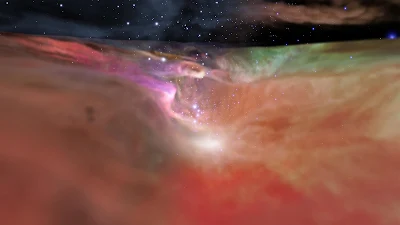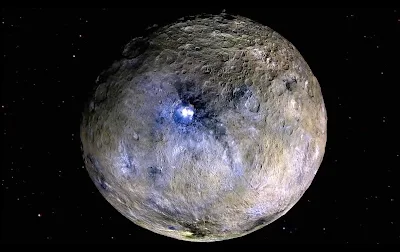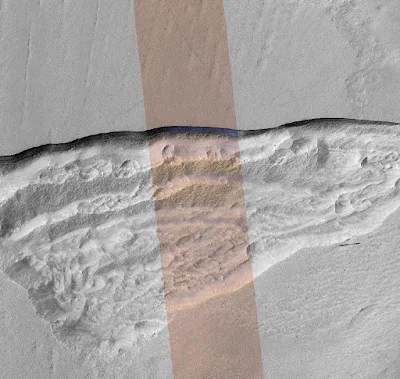This image
showcases both the visible and infrared visualizations of the Orion Nebula.
This view from a movie sequence looks down the 'valley' leading to the star
cluster at the far end. The left side of the image shows the visible-light
visualization, which fades to the infrared-light visualization on the right.
These two contrasting models derive from observations by the Hubble and Spitzer
space telescopes. Image credit: NASA/ESA/STScI/Caltech-IPAC
Το Νεφέλωμα
του Ωρίωνα, γνωστό και ως Μεσιέ 42 (Μ42), είναι ένα νεφέλωμα
του Γαλαξία μας νότια από τη Ζώνη
του Ωρίωνα, στον αστερισμό του Ωρίωνα. Είναι ένα από τα φαινομενικώς
φωτεινότερα νεφελώματα, ορατό με γυμνό μάτι σε σκοτεινό
ουρανό. Το Νεφέλωμα του Ωρίωνα απέχει από τη Γη 1344 ± 20 έτη
φωτός. Περιλαμβάνει την κοντινότερη στη Γη περιοχή παραγωγής νέων
αστέρων. Η πραγματική του διάμετρος εκτιμάται σε 24 έτη φωτός. Το Νεφέλωμα
του Ωρίωνα είναι ένα από τα πλέον ερευνηθέντα και φωτογραφημένα ουράνια σώματα.
Η μελέτη του έχει αποκαλύψει πολλά μυστικά για τη διαδικασία σχηματισμού
νέων άστρων και πλανητών από τη βαρυτική κατάρρευση νεφών
διαστρικού αερίου και σκόνης.
This visualization
explores the Orion Nebula using both visible and infrared light. The sequence
begins with a wide-field view of the sky showing the plane of our Milky Way
Galaxy, then zooms down to the scale of the Orion Nebula. The visible light
observation (from the Hubble Space Telescope) and the infrared light
observation (from the Spitzer Space Telescope) are compared first in
two-dimensional images, and then in three-dimensional models. As the camera
flies into the star-forming region, the sequence cross-fades back and forth
between the visible and infrared views. The glowing gaseous landscape has been
illuminated and carved by the high energy radiation and strong stellar winds
from the massive hot stars in the central cluster. The infrared observations
generally show cooler temperature gas at a deeper layer of the nebula that
extends well beyond the visible image. In addition, the infrared showcases many
faint stars that shine primarily at longer wavelengths. The higher resolution
visible observations show finer details including the wispy bow shocks and
tadpole-shaped proplyds. In this manner, the movie illustrates the contrasting
features uncovered by multi-wavelength astronomy. Credit: NASA, ESA, and F.
Summers, G. Bacon, Z. Levay, J. DePasquale, L. Hustak, L. Frattare, M. Robberto
(STScI), R. Hurt (Caltech/IPAC), M. Kornmesser (ESA), A. Fujii
Ένα
νέο βίντεο που κυκλοφόρησε από τη ΝΑSA εστιάζει στο Νεφέλωμα του Ωρίωνα,
συνδυάζοντας δεδομένα ορατής και υπέρυθρης ακτινοβολίας από τα διαστημικά
τηλεσκόπια Hubble και Spitzer. Έτσι μας αποκαλύπτονται χαρακτηριστικά του
νεφελώματος που διαφορετικά θα ήταν αόρατα στους ανθρώπους.
Πηγές:
hubblesite.org – physicsgg



















